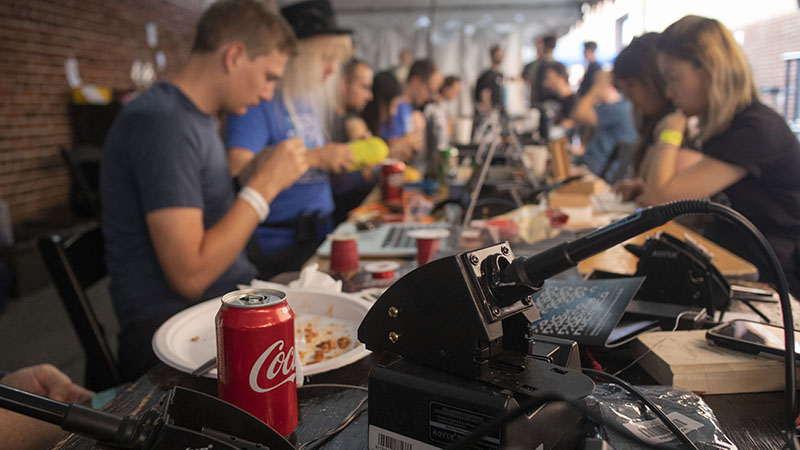At the end of Hackaday Superconference weekend, we hold a badge hacking ceremony on the main stage where anyone who has done anything with their badge is invited to come on stage and show off their work. Yes, even if it’s just a blinking LED! It was a tremendous pleasure to see not only people taking us at our word and presented blinking LEDs, but that the community in the room welcomed these inductees to hardware hacking with cheers. Before the ceremony, though, there was a lot of frantic work by badge hackers armed with soldering irons and fueled by caffeine. It’s always amazing how much people can accomplish in a single focused weekend.
In our previous overview of Supercon badge hacking, [macegr] had only an expansion board holding a USB to serial converter out of convenience. It has since grown to an LED array and, by the end of the night, an implementation of Conway’s Game of Life. Quite an evolution for something that began as a humble serial converter! Speaking of convenient ports, [Drew] and [Mike L] added a PS/2 keyboard port to their badge. The functionality, however, was only half of the story. The other half was their resourcefulness using parts scavenged from items in the goody bag given to Supercon attendees.
On the other meaning of the word “port”, [Marcel] ported an emulator for his Gigatron TTL computer to run on his badge. [Nick] dove into the Z80 emulator on his badge sporting an enclosure by [Tim]. [Nick]’s goal was to get SuperCalc (one of the original spreadsheet programs) to run. And [SHAOS] worked to port his XORLib project to his badge.
Multiple projects added audio input to the badge. [swap file] fed a microphone into a Teensy which commanded the badge to visualize music on screen along with copious LEDs. [Scott] went a different route – the audio signal is routed to electrodes worn on the skin, allowing the wearer to hear through their skin. We even have a MATRIX Voice microphone array brought by [Tucanae47].
On the output end of badge audio, some pretty great noisemakers were built. [Todd] applied what he had just learned at the “Logic Noise: Breadboard Your Own Primitive Synthesizer” workshop towards a badge hack. [Tony] and [Dan] built a phased speaker array intended to help the visually impaired. And [EdjeElectronics] cranked badge music volume up to 11 with an amplifier that drives a speaker almost as large as the badge itself.
Quite a few projects used the badge’s expansion port to interface with interesting hardware, exactly as the badge design intended. [Ben] showed off a badge that, at first glance, was running a Linux distribution. Then he would explain his illusion: the black box attached to the badge is a Raspberry Pi enclosure and the badge is a terminal. [Diego]’s Maker Muscle is controllable by pretty much any controller out there, and that list now includes the badge. [Jordi] went with the thinking that more computing power is always better, so his badge expansion board is now home to a 1bitsy board, an ATMega32 board, and a RISC V board. Just getting them to coexist is impressive enough. And checking in on another team covered in the previous overview, [morgan] and [Ben] got their wireless mesh network up and running an hour before the ceremony. (Plenty of time!) Badges on the network are each equipped with a minimalist ESP32 add-on and a ton of software magic.
How did all these projects – plus many more – turn out at the end of the weekend? See for yourself at the badge hacking ceremony. We loved seeing all these tremendous badge hacks this year, and we invite you to join us for the next Hackaday Superconference.






























And when they say “time’s up” they’re serious. The furniture rental company came in at 5pm of so and they made like Michael Jackson and wanted to “clear the area RIGHT NOW”.
My 6502 computer (Apple 1 emulator) add-on was basically done but without a soldering iron I couldn’t fix the minor mistake that I had made: I wired up the serial connection to the wrong two pins.
See https://hackaday.io/project/3620-l-star-software-defined-6502-computer/log/155608-l-star-as-a-supercon2018-badge-add-on for a write-up.
I saw that over on .io, man, what a bummer :(
Super bummer, because that’s one of the nicest uses of the breakout board that I’ve seen! But surely you could have borrowed someone’s iron? I saw about a million of thos USB-powered jobbies floating around.
But yeah. Catering don’t play.
Thanks Elliott!
Yeah, actually the guy who pointed out my mistake with the serial port lines (thanks again whoever you are!) had a USB solder iron. But even if I would have borrowed that for 5 minutes to fix the problem, it would have still taken me another half hour or so to get the software to work, and by that time we were already in the middle of the badge hacking ceremony on the main stage.
===Jac
Is anyone else worried about the proximity of the food and drink to the soldering equipment?
Those just add some extra flavor and flagrance to the rosin smoke and the lead.
One of the advantages of hacking your badge was that you could go get food and then precariously balance it on/near your laptop and soldering iron. Anyone not hacking their badge had nowhere else to sit and eat, other than the ground (food/drink weren’t allowed inside). Solder and snipped off component leads in your bagel was a small price to pay!
Post up hacks to Hackaday.io, then submit to https://hackaday.io/list/162221-2018-supercon-badge-hacks